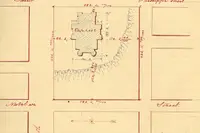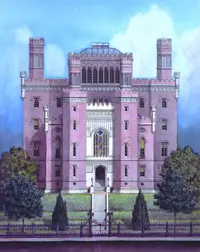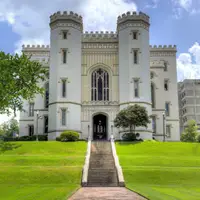
The History
Beginnings
Baton Rouge became the State Capitol in 1845 when a new state constitution mandated the location be “not less than 60 miles from the city of New Orleans.” Leaders were concerned about the concentration of wealth and power in the Crescent City – and the many distractions New Orleans offered.
Baton Rouge officials chose the first high spot on a natural levee that would be convenient for travelers, near the center of the city and safe from the Mississippi’s seasonal floods.
Architect James Dakin’s plans for the new statehouse were quickly selected by the Legislature. Dakin envision a unique and awe-inspiring building with prominent Gothic style architecture. “In making this design, I have endeavored … to adopt such a taste and style of architecture as would at once give the edifice a decided distinctive, classic and commanders character,” Dakin wrote. Workmen began clearing land in July 1847, and the official groundbreaking was held in October. The Legislature met for the first time in the new building in January 1850 under Gov. Isaac Johnson.

Secession and relocation
By 1861, the simmering debate over slavery boiled over into a bloody Civil War that ripped the country apart. Delegates met here on January 26, 1861 and voted to secede from the United States of America. The Weekly Gazette & Comet described the scene: “A shout as never before went up from the old Gothic Building.” Louisiana became the Sovereign and Independent Commonwealth of Louisiana for two months before joining the Confederate States of America.
In 1862, the state government fled to Opelousas in advance of Union troops. The capitol would retreat farther north to Shreveport before the war ended.
In Baton Rouge, Union troops quickly captured the capitol using it as a command post, prison and garrison. No one knows definitively the case, but a fire broke out while troops occupied the building. They tried unsuccessfully to extinguish the fire. The building was gutted; only the exterior walls remained.

A New Castle
While the old statehouse lay in ruins, the state Capitol moved to New Orleans after the war ended. By 1879, a constitutional convention again designated Baton Rouge as the capitol. The Legislature allocated $153,000 to repair the statehouse and chose William A. Freret as the architect.
Freret’s design added a fourth floor, a breathtaking stained glass dome, cast iron spiral staircase, and turrets on top of exterior towers. Feret completed the building in 1884 and within budget.
But fire again took its toll on the building in 1906 faulty wiring led to a blaze that destroyed the Senate. Repairs restored the chamber to its previous elegance.

The Battle with Huey P. Long
When Gov. Huey P. Long took office in 1928, it was clear that he was not fond of the State Capitol. Long famously said he wouldn’t charge anyone who burned it down.
The statehouse was the scene of many arguments and even fistfights as Long’s populist agenda and strong-arm tactics did not sit well with some lawmakers.
House of Representatives members impeached Long in April 1929 on charges ranging from bribery to misuse of state funds. But there would be no trial. Convicting Long would require a two thirds majority in the Senate. Enough senators signed a letter saying they would never vote to impeach no matter what the evidence.
Long returned to his ambitious building plans, which included a new more modern capitol. The Legislature went along, and the new State Capitol opened in 1932.

Another Chapter
The Gothic castle became home to the Works Progress Administration of Louisiana in 1936, and extensive renovations and repairs were done. After World War II, the building was dedicated to Louisiana veterans in 1948. Veteran’s organizations move in and occupied the building until is closed for restoration in 1991. Although the building was falling into disarray, it earned the designation of National Historic Landmark in 1976. The building became part of the Louisiana State Museum system.
A New Mission
In 1990, for the first time in 58 years, the Louisiana Legislature convened in the Old State Capitol. It was the beginning of a rebirth. The building was transferred to the Office of the Secretary of State, and the building closed for three years while the building underwent an extensive and comprehensive restoration.
Secretary of State Fox McKeithen reopened the building in 1994 as a political history museum. Its mission is to educate the public about the state’s rich political history and inspire engaged citizenship. Today, the Old State Capitol welcomes guests from around the world. The museum is accredited by the American Alliance of Museums, the highest credential awarded to museums.
